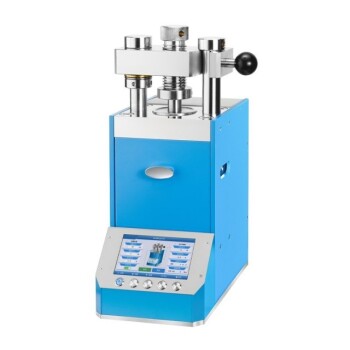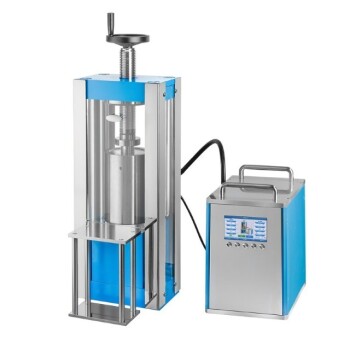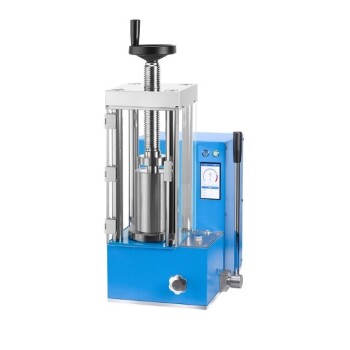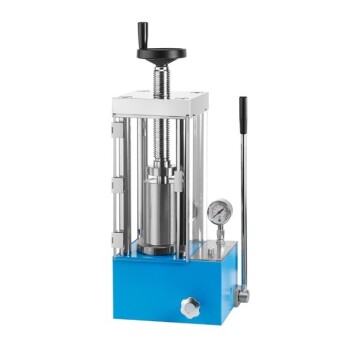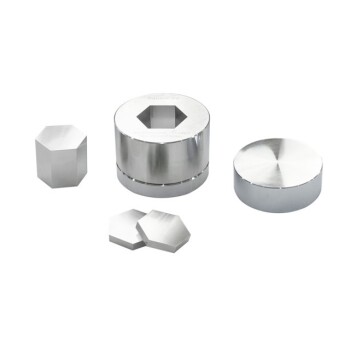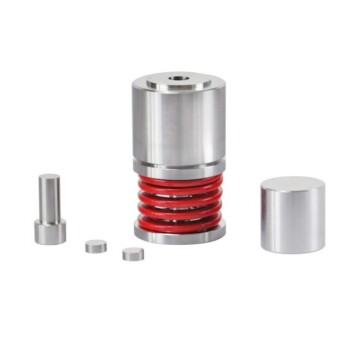To optimize a Cold Isostatic Pressing (CIP) process, businesses must focus on three core pillars: rigorous equipment maintenance, strategic material selection, and precise process control. This holistic approach ensures consistent part quality, maximizes material strength, and reduces operational costs by minimizing waste and cycle times.
True optimization of CIP isn't about maximizing a single variable like pressure. It's about achieving a strategic balance between your equipment's capabilities, your material's properties, and your desired final part characteristics to produce uniform, high-strength components reliably and cost-effectively.

The Foundations of CIP Optimization
Optimizing your CIP operations requires a systematic approach that addresses each element of the process. Weakness in one area will inevitably compromise the final result, regardless of strength in others.
Mastering Your Equipment
Your pressure vessel and hydraulic systems are the heart of the CIP process. Their reliability dictates the consistency of your output.
Regular, preventative maintenance is non-negotiable. This includes routine checks on hydraulic systems, seals, and the integrity of the pressure vessel itself to prevent failures and ensure uniform pressure application.
Beyond maintenance, you must understand your equipment's operational envelope. This includes its maximum pressure range and chamber capacity, which define the physical and geometric limits of the parts you can produce.
Strategic Material Selection
The success of CIP is fundamentally tied to the material being processed. The goal is to select a powder that not only withstands the pressure but also compacts in a predictable way.
Your chosen material must be capable of achieving the desired "green" density and strength. Different materials behave differently under pressure, affecting compaction and the final properties of the component.
Consider partnering with suppliers or specialists who understand the nuances of powders for isostatic pressing, including particle size distribution and morphology, which are critical for uniform densification.
Refining Process Parameters
This is where you translate equipment capability and material properties into a high-quality component. Precise control is key.
Continuously monitor and adjust key process steps. This includes the pressure ramp rate, hold time at maximum pressure, and depressurization rate.
The goal is to develop a repeatable "recipe" for each part and material combination. This minimizes variation between batches, reduces waste from rejected parts, and improves overall efficiency.
Understanding the Trade-offs
Effective optimization requires acknowledging that every decision involves a trade-off. Pushing one parameter to its limit often comes at the expense of another.
Pressure vs. Cost and Throughput
While higher pressure often leads to greater density, it also increases stress on equipment, potentially leading to more frequent maintenance and higher energy consumption.
Extremely high pressures can also extend cycle times, reducing overall throughput. The optimal pressure is one that achieves the necessary part density without unnecessarily straining your operational budget or schedule.
Tooling Complexity vs. Reliability
CIP allows for complex shapes, but intricate tooling (the flexible mold or bag) can be more prone to failure. These molds can also create areas where pressure is not applied perfectly uniformly.
Often, a simpler, more robust tooling design provides greater process reliability and more consistent part quality, even if it requires post-press machining.
Cycle Time vs. Part Quality
Reducing cycle times by using faster ramp rates or shorter hold times can increase production volume.
However, this can introduce internal stresses or result in incomplete or non-uniform densification, compromising the mechanical integrity of the final part. A slower, more controlled cycle almost always yields a superior component.
Tailoring Your Optimization Strategy
Your specific goals should dictate your optimization priorities. Use these guidelines to focus your efforts where they will have the most impact.
- If your primary focus is part quality and performance: Prioritize precise process control and select materials specifically engineered for superior compaction, even if it extends cycle times.
- If your primary focus is cost reduction and throughput: Concentrate on preventative maintenance to maximize uptime and refine cycle parameters to be as efficient as possible without sacrificing essential quality.
- If your primary focus is research and development: Invest in versatile equipment with a broad pressure range and capacity to allow for experimentation with novel materials and complex part geometries.
Ultimately, a well-optimized CIP process transforms raw powder into a predictable, high-value component.
Summary Table:
| Optimization Pillar | Key Focus Areas | Benefits |
|---|---|---|
| Equipment Maintenance | Regular checks on hydraulic systems, seals, and pressure vessel | Prevents failures, ensures uniform pressure application |
| Material Selection | Powder properties like particle size and morphology | Achieves desired green density and strength, enables uniform densification |
| Process Control | Pressure ramp rate, hold time, depressurization rate | Minimizes variation, reduces waste, improves efficiency |
Ready to optimize your Cold Isostatic Pressing process? KINTEK specializes in lab press machines, including automatic lab presses, isostatic presses, and heated lab presses, tailored to meet your laboratory needs. Our expertise helps you achieve consistent part quality, maximize material strength, and reduce operational costs. Contact us today to discover how our solutions can enhance your CIP operations!
Visual Guide
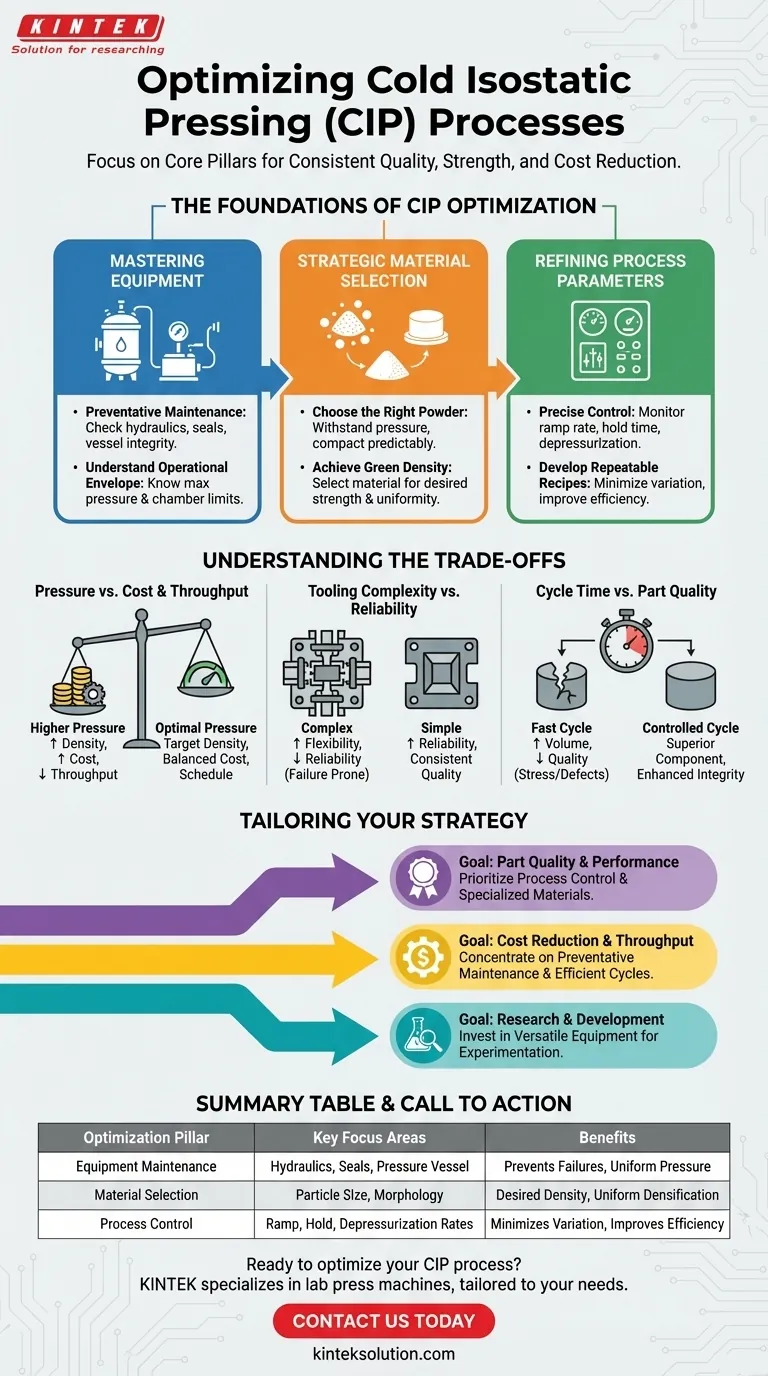
Related Products
- Automatic Lab Cold Isostatic Pressing CIP Machine
- Electric Split Lab Cold Isostatic Pressing CIP Machine
- Electric Lab Cold Isostatic Press CIP Machine
- Manual Cold Isostatic Pressing CIP Machine Pellet Press
- Automatic Laboratory Hydraulic Press Lab Pellet Press Machine
People Also Ask
- What role does CIP play in advanced technologies like solid-state batteries? Unlock High-Performance Energy Storage Solutions
- What is the significance of Cold Isostatic Pressing (CIP) in manufacturing? Achieve Uniform Parts with Superior Strength
- What are the common forming processes in advanced ceramics? Optimize Your Manufacturing for Better Results
- What is the advantage of cold isostatic pressing in terms of controllability? Achieve Precise Material Properties with Uniform Pressure
- How is cold isostatic pressing energy efficient and environmentally friendly? Unlock Clean, Low-Energy Manufacturing
